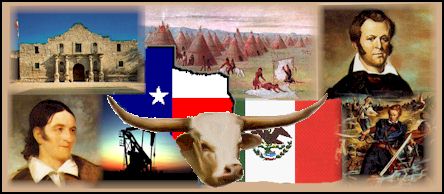|
|
|
|
|
| |
|
The History of Hunt County Texas

 Hunt
County is located in northeastern Texas and is bordered
by the counties of
Fannin
(on the north); Delta,
Hopkins
(on the east); Rains
(on the southeast); Van
Zandt, Kaufman (on
the south); and Rockwall
and Collin
(on the west). No other county in Texas is bordered by more counties.
Greenville
is Hunt County's seat and its largest city. Hunt County consists
of approximately 840 miles of the Texas Blackland Prairie. Hunt
County is located in northeastern Texas and is bordered
by the counties of
Fannin
(on the north); Delta,
Hopkins
(on the east); Rains
(on the southeast); Van
Zandt, Kaufman (on
the south); and Rockwall
and Collin
(on the west). No other county in Texas is bordered by more counties.
Greenville
is Hunt County's seat and its largest city. Hunt County consists
of approximately 840 miles of the Texas Blackland Prairie.
The first Europeans to pass through Hunt County were French. Seutter's
1735 map of the Texas area shows that St. Denis, a trader traveling between
from Louisiana to the Rio Grande, passed through Hunt County and crossed
the forks of the Sabine in 1713 and again on his return journey in 1716.
In 1787, a French-Spanish expedition headed by Vial and Fragosa also crossed
through the county. Evidence of their journeys in the form of blue trading
beads were discovered during the construction of Lake Tawakoni in the 1960s.
Though the Mexican government issued a small number of land grants in the
area that is now Hunt County in 1835, settlement did not begin until 1838-1839.
The first settlers arrived in the area that is now Hunt County around 1840.
These early settlers found tribes of Kiowa, Caddo and Tawakoni Indians
settled amidst the tall native prairie grass and large thickets.
Approximately 500 people lived in the county when it was formed from Fannin
and Nacogodoches Counties by the first legislature of Texas in 1846. The
official act to create Hunt County was signed on April 11, 1846.
Hunt County's early settlers came mostly from
Tennessee,
Kentucky
and states in the deep south such as Alabama,
Georgia
and Mississippi. Many of
the county's early settlers also came to stake claim to land grants from
the Republic of Texas, or as a part of Charles
Fenton Mercer's colony.
The county was named for
Memuchan
Hunt, the first Texas minister to the United States. Greenville,
which was established on land donated by McQuinney Howell Wright and James
G. Bourland, became the county seat. Greenville, the county seat, is named
for Thomas
Jefferson Green, who, among other things, was second in command of
the Meir Expedition. Narrowly named Pickneyville in honor of Governor
J. Pickney Henderson, a change was written in at the last moment, and the
first seat of Collin County ended up named as such. The first sale
of town lots for Greenville was held in 1846, though the city was not officially
incorporated until 1850. This was because after the initial survey
was done, it was decided that the format of the town needed to be moved
somewhat so that trees for lumber would be included in the town site.
Because the surveyor had gone, and was not located until 1850, Greenville
was not incorporated until that time.
In 1861, Hunt County became sharply divided over the issue of secession.
While Martin and Hardin Hart were among the vocal opponents of secession,
a close vote of 416 to 339 cast the county's lot with the remainder of
the south. One of the many reasons for southern sympathies was not
because of an overabundance of slave owners, however. (557 slaves
were held by only 142 of the 6,053 members of the white population.)
It was likely because most of the area's settlers came from states in the
south. By the end of the Civil War, the county's slave population
boomed to over 1200 as slaves from the deep south were sent to Texas in
order that they might be kept for safekeeping.
Federal Reconstruction in Hunt County was marked by a number of fights
and violent outbursts between Unionists and former Confederates.
The worst of these, the Lee-Peacock
Feud
[Texas
Feud Link], escalated to the point that army troops were called in
to restore order in January 1869. A Freedman' bureau office also
existed in the county, and made some strides in the area of black education
and enfranchisement.
In October, 1880, the first train came into Greenville on tracks laid by
the East Line and Red River Railroad. The next year the Missouri,
Kansas and Texas Railroad (M. K. & T.), extended its line from
Mineola
to Greenville. By 1905, most areas of the county were crossed by
multiple rail lines.
The coming of the railroads marked a dramatic turning point in the history
and the economy of the county. The coming of the railroads facilitated
the wide-spread growth of cotton, a crop well-suited to the Texas Blackland
Prairie. Cotton brought
in a new 'wealth' to the county. A large service economy developed
to cater to the masses now able to deal in cash as opposed only to trade
goods.
Impacted greatly by the Great Depression, the value of county farms was
about half of their 1920 value. By 1935, over 2,000 heads of households
were on some type of government relief program. The WPA flourished
in the county, aiding in the construction or roads and bridges, and in
that of Greenville's Municipal Building and auditorium.
Though agriculture remains a significant force in the county's economy,
the number of farms began to dwindle after World War II. The decline
continues to the present. Today, Hunt County is home to a diverse plethora of industries, from defense
contractors to fiberglass manufacturing and light industry. It is
home a
university,
technical schools, and several large communities.
The
Seven Courthouses of Hunt County
The first county courthouse was a log structure and was built in 1847,
and was followed by six other structures including the present Art Deco/Greek
Revival structure located in Greenville. The first courthouse measured
only twenty by twenty two feet. William Richey was awarded the contract
for its construction on January 16, 1847. The second courthouse was
another wood building, built in the summer of 1853. Chief Judge of
the county Louis Moore offered to construct the courthouse, either by adding
on to the log structure, or building another out of plank hauled from a
saw mill quite a distance away. The plank structure was finally constructed
on the south side of the square. In 1854, a traveler to Greenville
called the evidently un-magnificent structure a "small box house."
The county's third courthouse, and the first brick courthouse, was erected
in 1858-59. Apparently, the structure was unsafe after only fifteen
years of use, as it was condemned on September 9, 1874. The county
then bought the Methodist (forerunner of Wesley United Methodist
Church) church building for a courthouse, which later became a union church.
The county then rented two store buildings east of the church building
as county offices which served until 1883.
After the railroads arrived, a contract was let on January 7, 1882 for
the construction of the first "modern" courthouse. The two story
structure was erected in the center of the square by D. R. Smith of Pittsburg
for $35,600. The architect for the building was W. C. Dodson, who
was paid $1,226. This building was condensed to ashes during the
'great fire' in 1884 which wiped out the west side of the square as well
as part of the south side of the square.
A near exact duplicate of this structure was erected on the same site in
1885 from insurance funds collected from the previous structure. J.M. Ellis and Richard Graham, builders of the county jail, were the contractors
for the project which cost $40,000. The building measured 86 1/2
feet by 88 1/2 feet, and the top of the building's cupalo was 100 feet
off the ground.
This courthouse was razed in 1928 to make way for Hunt County's seventh
courthouse, completed and Dedicated on April 11, 1929. In the interim,
county offices were held in the bottom floor of the Masonic Lodge building
at 2613 Stonewall. The construction of the massive, five story Art
Deco and Greek Revival courthouse topped $400,000. Today, it is valued
at approximately $1.5 million dollars. William Ragsdale of Greenville
was the principal architect, and Ben W. Shepherd and Son of Greenille was
the principal contractor. Today, the building is a Recorded Texas
Historic Landmark and is on the National Register of Historic Places.
Copyright TXGenWeb
|
| |
|

